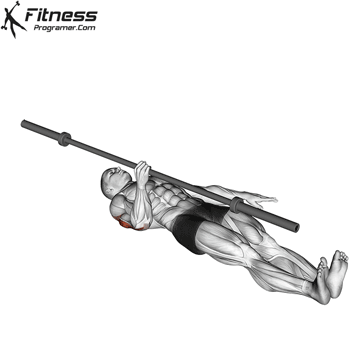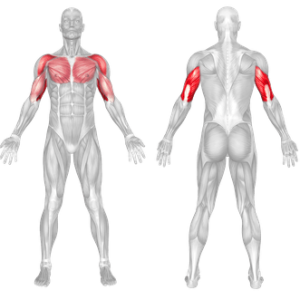Overview
The one-arm barbell floor press is a unilateral strength exercise that challenges the upper body. By performing the press from a lying position on the floor, the range of motion is slightly reduced, which helps protect the shoulder joints and places a greater emphasis on the lockout phase of the lift. This variation necessitates substantial core activation and shoulder stabilization, effectively making it both a pressing and anti-rotational exercise.
This exercise is particularly beneficial for correcting muscle imbalances between sides, enhancing unilateral strength development, and building a solid foundation for heavier bilateral lifts. Due to its requirement for balance and controlled movement, it is frequently incorporated into functional strength training, rehabilitation, and sports performance programs.
How to Perform the Barbell One Arm Floor Press

Step 1: Setup
Position a loaded barbell on the floor with light weight.
Lie down with your body perpendicular to the bar, with the bar positioned above one shoulder.
Bend your knees slightly or keep your legs extended to increase core challenge.
Grip the barbell with one hand in a neutral or overhand grip near the sleeve.
Use your free hand to help lift the bar into position if needed.
Step 2: Execution
Press the barbell upward by extending your arm, making sure the bar stays balanced and aligned over your shoulder.
Pause briefly at the top, keeping your wrist stacked over the elbow and the bar centered.
Slowly lower the bar down until your triceps lightly touch the floor.
Keep your elbow close to your side during the descent.
Complete the desired reps, then switch arms and repeat.
Tips for Proper Form
Start with light weight to get comfortable balancing the bar with one arm.
Keep your core braced throughout the movement to avoid rotation.
Use your free hand to assist in lifting or racking the bar safely.
Keep your wrist neutral and aligned with your elbow and shoulder.
Lower the bar slowly to enhance control and avoid injury.
Common Mistakes to Avoid
Using too much weight before mastering control, which can lead to poor form or injury.
Letting the bar tilt or rotate, which compromises safety and effectiveness.
Overextending your wrist, which increases strain and instability.
Neglecting core engagement, leading to loss of balance or trunk rotation.
Dropping the bar too quickly, reducing time under tension and control.
Benefits of the Barbell One Arm Floor Press
1. Builds Unilateral Upper Body Strength
By isolating one arm at a time, this exercise addresses muscular imbalances between sides, promoting better overall symmetry and performance.
2. Enhances Triceps and Chest Activation
The floor press emphasizes the lockout portion of the lift, placing greater stress on the triceps and front deltoids, ideal for pressing strength.
3. Improves Core Stability and Anti-Rotation Strength
Due to the single-arm loading, your core must resist rotation, improving oblique and transverse abdominis engagement.
4. Safer for the Shoulders
Performing the press from the floor limits range of motion, reducing the risk of shoulder hyperextension or strain.
5. Develops Joint and Grip Stability
The single-arm barbell hold challenges wrist and shoulder stability, helping to strengthen smaller stabilizing muscles.
How to Incorporate Into Your Routine
For Strength: Perform 3 to 4 sets of 6 to 8 reps per arm using a controlled tempo.
For Hypertrophy: Perform 3 to 4 sets of 8 to 12 reps per arm, focusing on contraction and full range of motion.
For Stability and Rehab: Use light weight and higher reps (12 to 15) with a strong focus on core control.
Pair With: Overhead presses, push-ups, dips, or unilateral pulling exercises like single-arm rows to create a balanced upper-body routine.
Muscles Worked

